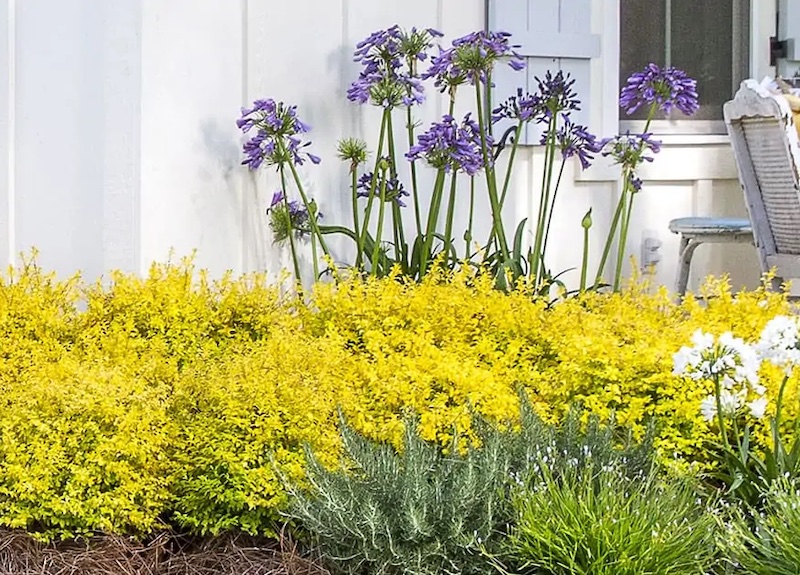Agapanthus Friend Plant Kingdoms: Perfect Pairings for Your Yard
Agapanthus Friend Plant Kingdoms: Perfect Pairings for Your Yard
Blog Article
Grasping the Art of Agapanthus Treatment: Important Steps for Healthy And Balanced Development and Dynamic Blossoms
In the world of cultivation, the farming of agapanthus stands as a gratifying endeavor for those who look for to support these stylish blooming plants. With their striking blossoms and elegant foliage, agapanthus has caught the interest of gardeners worldwide. However, achieving ideal growth and lively blooms requires a nuanced method that includes different important actions. From picking the appropriate selection to mastering pruning techniques, the trip in the direction of cultivating thriving agapanthus plants is diverse and holds the vital to opening the complete potential of these organic gems.

Picking the Right Agapanthus Variety

When choosing the appropriate Agapanthus variety for your garden, consider factors such as climate suitability, bloom color, and development routine. In addition, think about the environment in your area to make sure the Agapanthus variety you choose can grow in your certain conditions. Understanding the development practice of various Agapanthus varieties is crucial for proper placement within your garden.
Suitable Growing Conditions
Considering the ideal environmental requirements is necessary for effective Agapanthus cultivation. Agapanthus plants are delicate to cold temperatures and must be secured from frost during winter season months.
To make certain healthy growth and vibrant blooms, plant Agapanthus bulbs at a depth of regarding 2-4 inches and space them 8-12 inches apart. Mulching around the base of the plants aids maintain wetness and suppresses weed growth.
Watering and Fertilizing Tips
Preserving proper dampness degrees and offering essential nutrients are crucial elements in the treatment program for Agapanthus plants. When it concerns sprinkling Agapanthus, it is vital to strike an equilibrium. If overwatered, these plants choose regularly moist soil but are at risk to root rot. During the expanding season, water deeply when a week, making sure the dirt is well-draining to protect against waterlogging. In hotter climates or throughout durations of dry spell, more constant watering may be essential to keep the dirt uniformly damp. Nevertheless, lower watering in the winter months to stop water logged problems.
Feeding Agapanthus is crucial for promoting healthy and balanced growth and prolific blossoms. Apply a balanced plant food, such as a 10-10-10 formula, in the very early spring as new development arises. By complying with these watering and feeding suggestions, you can guarantee your Agapanthus plants grow and create lively, durable blossoms.
Pruning Strategies for Agapanthus
Pruning Agapanthus plants at the ideal times and with correct methods is crucial for preserving their wellness and advertising optimal growth and blooming. The suitable time to prune Agapanthus remains in late winter or early spring before new growth arises. Begin by getting rid of any kind of dead or yellowing leaves near the base of the visit site plant. Cut them as short as feasible without harming the emerging shoots.
Deadheading spent flowers can likewise reroute the plant's power into producing even more blossoms rather than establishing seeds. If you want to gather seeds for breeding, leave some flowers to completely dry and fully grown on the plant.
Keep in mind to utilize clean, sharp tools to make precise cuts and reduce the risk of presenting conditions. Agapanthus. Routine pruning will aid maintain your Agapanthus looking healthy and cool while making certain a plentiful display of stunning flowers
Taking Care Of Typical Pests and Illness
After guaranteeing appropriate trimming techniques for Agapanthus, it is important to attend to typical pests and illness that can impact the wellness and vitality of these plants. One common bug that impacts Agapanthus is the Agapanthus gall midge.
An additional common problem is fungal fallen leave area, which offers as dark sores on the fallen leaves. To avoid fungal conditions, ensure good air flow around the plants, avoid overhead watering, and eliminate any type try this out of infected leaves without delay. In addition, Agapanthus plants can suffer from root rot if they are planted in poorly draining dirt. To avoid this, plant Agapanthus in well-draining soil and prevent overwatering. By being watchful and taking prompt activity versus illness and parasites, you can assist your Agapanthus plants thrive and create vibrant flowers.

Verdict
Finally, grasping the art of agapanthus treatment includes choosing the appropriate range, offering excellent growing conditions, proper watering and fertilizing, appropriate trimming strategies, and attending to typical parasites and conditions. By adhering to these necessary steps, you can guarantee healthy growth and vivid flowers for your agapanthus plants. Remember to consistently keep an eye on and preserve your plants to promote their general health and longevity.
To guarantee healthy growth and lively blooms, plant Agapanthus bulbs at a depth of about 2-4 inches and space them 8-12 inches apart. By adhering to these watering and feeding suggestions, you can guarantee your Agapanthus plants prosper and generate dynamic, long-lasting flowers.
One usual bug that impacts Agapanthus is the Agapanthus gall midget. In addition, Agapanthus plants can experience from root rot if they are grown in poorly draining soil. By following these vital steps, you can make sure healthy and balanced growth and vivid flowers for your their explanation agapanthus plants.
Report this page